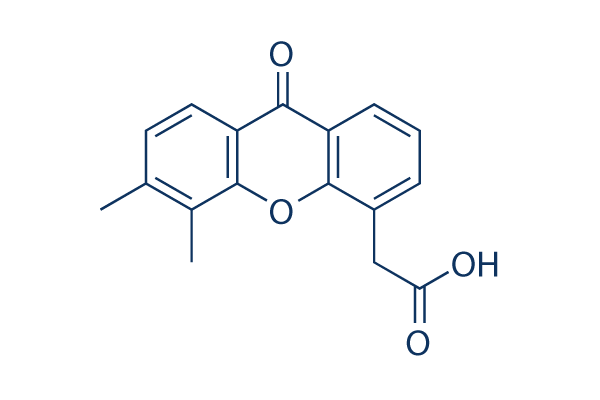| Description: |
Vadimezan (ASA-404; DMXAA), the vascular disrupting agent, is a murine agonist of the stimulator of interferon genes (STING) and also a potent inducer of type I IFNs and other cytokines. |
| In Vivo: |
344SQ-ELuc NSCLC subcutaneous tumors respond dramatically to Vadimezan (DMXAA), with a marked decrease in bioluminescence (BLI) signals post-drug injection. Vadimezan (DMXAA) treatment of 344SQ-ELuc metastases yields no decrease in photon emission rates, with the tumors remaining histologically similar to controls after this treatment. As with the large subcutaneous tumors, Vadimezan (DMXAA) administration to mice with small subcutaneous tumors still leads to ~2-log decreases in photon emission at both 6 and 24 hours[1]. In vivo, Vadimezan (DMXAA) is a more potent inducer of IFN-β mRNA and a relatively poor inducer of TNF-α mRNA. Vadimezan (DMXAA) administration leads to significantly less weight loss in influenza-infected mice[2]. |
| In Vitro: |
Vadimezan (DMXAA), the vascular disrupting agent, is a murine agonist of the stimulator of interferon genes (STING) and also a potent inducer of type I IFNs and other cytokines. Vadimezan (DMXAA) has no detrimental effect on 344SQ-ELuc cell viability. It is found that Vadimezan-mediated up regulation of the NF-κB pathway as shown by increased p65 phosphorylation in M2 macrophages[1]. Results demonstrate that Vadimezan (DMXAA)-treated cells are protected from VSV-induced cytotoxicity at all MOIs in contrast to medium-pretreated macrophages. Vadimezan (DMXAA) effectively inhibits growth of both strains of influenza, demonstrating the potential of Vadimezan for treatment of drug-resistant strains of human influenza[2]. |






















